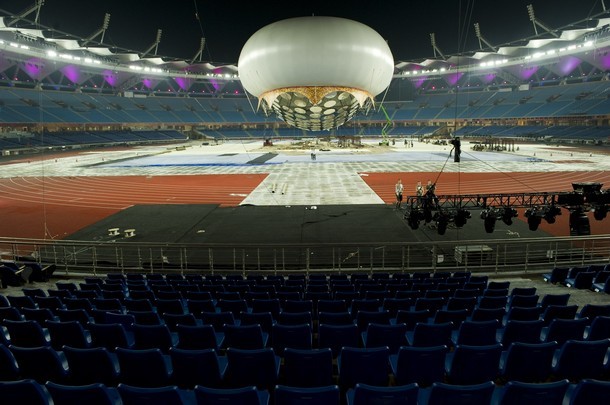Did the Commonwealth Games Live up to Expectations?
So the Commonwealth Games 2010 in Delhi has finished. What legacy do the Games leave? As I discussed in my last post, the run-up to the Games was mired in controversy, chaos and corruption as buildings were unfinished, bridges collapsed and there were cases of Dengue fever. Top athletes from around the world pulled out, nations threatened not to come and there were serious discussions about cancelling the event altogether.
But, in the end, Commonwealth Games Chief Mike Fennell has praised Delhi 2010 as a success, despite the initial problems. The media's histrionic panic before the Games and predictions of chaos and failure have turned out to be unfounded. The opening ceremony was simply spectacular, even if Committee Chairman Kalmadi thanked "Princess Diana" for coming, much to Camilla's confusion.
The withdrawal of several high-profile stars such as Usain Bolt and Phillips Idowu did not the overall sporting quality displayed at the Games. In the event, these withdrawals were nothing to do with safety concerns, but timing concerns: October is the end of the long athletic season, and safety concerns were an excuse to sit out the Games more than anything else. And the concerns about the athlete's village turned out to be hot air, as veteran competitors praised it as the best accommodation they had seen at a Commonwealth Games.
In the first few days, empty stadiums proved embarrassing, as problems with ticket organisation and security checks kept audiences away. Then something happened: Indians began turning out in droves for the Games; sports editors and journalists around the world seized on the excitement and mood as great sporting performances were delivered and the character of the Games suddenly became energetic and exciting. The changing atmosphere was spearheaded by Indian athletes, who delivered by far the best results in their nation's history and exceeded all expectations: the women's 4x400m team delivered the country's first track gold since 1958. Lord Coe believed it was the moment that could potentially change the course of athletics in India. Half of India's 1.2billion people are under 25, which is an enormous pool of untapped sporting potential. To compare with China: India has won 3 Olympic medals since 1984; China has won 420. Let us hope that the spectators' enthusiasm and athletes' promise is followed by genuine investment in grass-roots sport from central government and not just more platitudes. India should aim for a top ten medals finish in 2012, and to do that, the magnificent new sporting infrastructure must be used and not left to decay alongside the other great monuments of Delhi.
The Games exemplified the Indian principle of Jagaad, the idea that you can't do something perfectly on its first iteration: rather than spending years and fortunes trying to perfect a product or service and then put it on the market, you put out a product or service that does the job. Then, with feedback from users, you adapt and improve the product, eventually creating better and better products that perfectly fits users' demands. This idea is seen as being one of the main reasons for the worldwide success of Indian companies and people, to the extent that it is now taught in Business Management schools worldwide. Indians' ability to come up with solutions to problems was showcased here: the athletes' village being ready for competitors despite the reports in the run-up; the Indian Army putting up a bridge in days to replace the one which collapsed; the SWAT-like snake-catching task force which removed the reptiles who had made it into the athletes' village.
The Games have driven the development of Delhi, by giving it a deadline: the expansion of the Metro, which is now one of the most advanced railways in the world; the airport which has been brought up to international standards; roads have been re-built; Connaught Place has been refurbished and the railway station expanded. Every building project was prioritised, meaning what may have taken another 5 years was completed in time for the Games. It has given Delhi a real push in areas it needed. Also, it has shown up the corruption and political interference which hampers India's development more than anything. And because of the potential embarrassment, India has to be shown to doing something about this, such as appointing a committee to specifically look into the corruption, mismanagement and politicisation of the Commonwealth Games. Whether or not this overhauls India, it is a step in the right direction and another example of the Games overcoming the inherent inertia against change in India. This was India's first multi-national sports event since the Asian Games in 1982. It was an opportunity to see if India was ready for a potential 2020 Olympic bid and set out its stall as a country that is on the up.
In summary, the Games exceeded all expectations, both in terms of its hosting and in terms of sporting performances. Athletes and commentators have talked of being too quick to listen to scare stories and being overwhelmed by the enthusiasm and warmth of Indian spectators and hosts. The Games came on the back of David Cameron's high profile trade visit to India; Tata has just given the biggest foreign donation ever to Harvard Business School, which even has an Indian dean; the Bombay Stock Exchange is soaring; India has become one of the top Gap year destinations for British students; India just resoundingly defeated Australia in a cricket Test series. It is a good time for India. The Games have exceeded all expectations and shown the world that India can overcome enormous challenges to provide spectacular results with unparalleled enthusiasm. What remains to be seen is if this push in the right direction will be maintained, or if all the promises are as vacuous as the enormous balloon that was the centrepiece to the opening ceremony.



